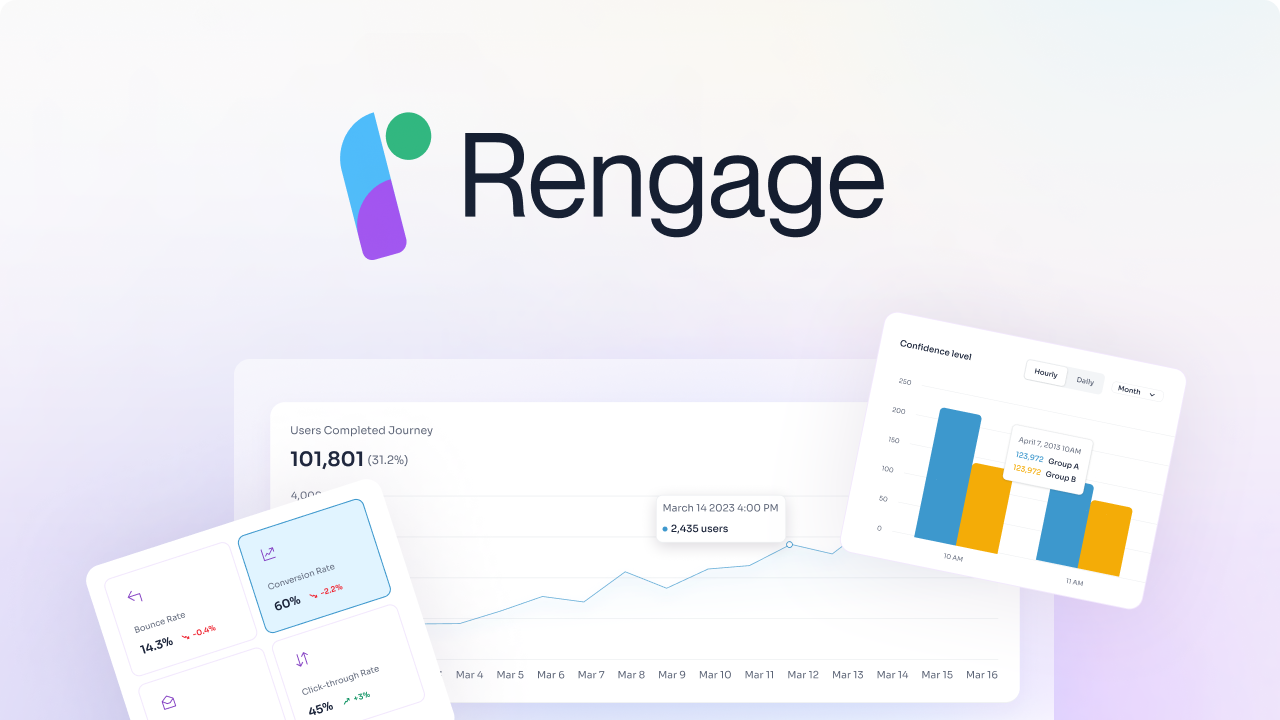Understanding the intricacies of this journey presents a roadmap for businesses to navigate the diverse challenges and capitalize on valuable chances for expansion. The customer lifecycle management is a critical aspect of the B2B customer journey that empowers businesses to nurture relationships, create brand loyalty and boost revenue.
What Is the B2B Customer Journey Mapping?

B2B customer journey mapping involves creating an illustration of the touchpoints and channels a customer typically uses when researching or interacting with your brand. This process helps you better understand what the buying journey looks like from your customers’ perspective. This valuable information is beneficial for your B2B marketing strategy because it helps you match the right content to each customer, regardless of how or where they interact with you.
Importance of B2B Customer Journey Mapping
Mapping the B2B customer journey is indispensable for understanding your customer’s experience from initial contact to long-term loyalty. It helps businesses identify customer touchpoints, pain points, and opportunities for engagement. This understanding allows businesses to tailor their marketing efforts to better meet the needs and expectations of their customers.
B2B Customer Journey Mapping vs. B2C
B2B customer journey mapping differs from B2C in several key ways. In B2B, you’re selling to an entire team or group of people, all of whom might have input in the purchase decision, making the decision-making process more involved. Deals in B2B transactions are typically larger, and the sales cycles are longer due to the complexity of the purchase decision.
Emotional factors play a significant role in B2B decision-making, where customers are more emotionally connected to their vendors and service providers than in B2C transactions. This emotional connection often influences decisions based on which provider is the best ‘fit’.
Related Reading
• Customer Lifecycle Management Best Practices • Customer Journey Analytics • Customer Journey Stages
What Are the 4 Stages of the B2B Buyer Journey?

Awareness
The first stage of the B2B buyer journey is Awareness. Here, the buyer is just beginning to learn about your company, products, and services. This phase requires the assistance of your sales and customer success teams. The marketing team plays a crucial role by creating content and utilizing digital channels like websites and social media to reach potential customers. During this phase, understanding the prospect or client's actual business needs and pain points is crucial. Demonstrating how your business can address these needs is pivotal.
Consideration
The Consideration stage serves to show how you can help potential buyers solve their issues while instilling confidence in the quality and competitiveness of your offering. Your sales team can nurture potential customers through the use of case studies, guides, effective in-person engagement, and comparative content. The goal here is to help potential clients understand your solutions once they are aware of them.
Decision
The Decision stage is the final phase of the B2B buyer journey. At this point, potential customers will decide which of your products or services they are most interested in. They may reach out to sales, but sales teams might need assistance from marketing with product demos, customer testimonials, and product reviews to transfer marketing leads into sales lead generation.
Loyalty
Once a customer has made a purchase, it is time to create a lasting relationship by offering excellent customer service, ongoing support, and opportunities for upselling. Encouraging customers to share their positive experiences through testimonials, referrals, or online reviews can help build brand awareness.
6 Key Benefits of Creating a B2B Customer Journey Map

Improving the customer journey can help companies reduce their cost-to-serve by 15-20%. One of the most authoritative ways to increase income and conversion is to guarantee that you don’t miss, underestimate, or overestimate any crucial encounters. When it comes to B2B customer journey mapping, these are some of the main benefits:
1. Identify Touchpoints with High Conversion Rates
Using customer journey mapping, you can compare conversion rates across different touchpoints. The term touchpoint refers to any type of customer encounter with your brand, whether it’s a personal recommendation, an online blog post review, or a sponsored advertisement.
2. Improve Customer Experience
If your customers have had a bad encounter with your brand, you may use a path map to figure out what went wrong. For example, they may have been hesitant to make a purchase since they were unable to speak with a salesperson beforehand.
3. Increase Customer Loyalty
If you can optimize the customer journey map, you may see an increase in sales over time. Customer loyalty can grow organically as a result of exceeding the expectations of your existing and new clients.
4. Reduce Costs
Companies often adopt cross-functional cooperation, which is when employees from various departments work together to attain a common goal. Using this method may result in lower costs and improved employee satisfaction.
5. Improve Brand Reputation
Having a good reputation is imperative for every organization, especially in today’s world where everything that happens to your firm is quickly public knowledge. There are many ways to develop your company’s reputation as a reputable, serious, and value-oriented business. Still, one of the most effective ways is simply doing your job well and continuing to provide value to your customers by understanding their journeys across different channels.
6. Identify Key Issues
Personalization is critical in marketing because every customer’s experience is unique. This is predominantly accurate when it comes to their interests, values, and motivations. By tracking each customer's journey, you may discover which marketing methods resonated with some customers and which didn’t. It is possible to adapt your efforts to fit the needs of different target audiences based on this data.
What Are the 4 Key Components of a B2B Customer Journey Map

Customer Personas
Customer personas are not just about demographics; they're about understanding your ideal customers on a deeper level. This includes their goals, challenges, and motivations. Personas also help you empathize with your buyers and recognize what information they need at each stage of the journey.
Stages of the Journey
The four stages of the customer journey are: Awareness Consideration Decision Loyalty
Each stage is vital, and each has numerous programs and plays you can run. Early-stage demand generation, for example, is most effective in the awareness and consideration stages, but in no way is it restricted to these stages.
Touchpoints
Touchpoints are where customers engage with your brand. This includes seeing an ad, attending a webinar, or speaking to a salesperson.
Emotions and Pain Points
Emotions are high-stakes factors in B2B customer journey mapping that can spell the difference between success and failure. Emotional resonance is powerful, and even rational B2B buyers need to feel good about their decisions.
A Potetial Customer Example
Imagine a potential customer who sees a LinkedIn ad for your project management software. A solid B2B customer journey map will not only note this as the 'awareness' stage but also capture what motivated them to click that ad, how smoothly they transitioned to your website, and what obstacles they might face as they research your solution.
10 Essential B2B Customer Journey Mapping Steps

1. Develop Buyer Personas
Developing buyer personas is essential for understanding the various types of customers and their needs. By creating different personas, you can explore how efficient your customer journey is for each persona. This involves considering diverse demographics, pain points, technology preferences, and overall requirements.
2. Define the Buyer's Goals
Each buyer has different priorities and concerns. Some may focus on price, while others prioritize features or quality. Assign distinct goals to each persona to understand how well your customer journey caters to them.
3. Diagram the Buyer’s Journey
Creating a flowchart of the buyer’s journey allows you to visualize the steps necessary to reach the end goal. The flowchart typically includes Awareness, Consideration, Purchase, Onboarding, and Advocacy stages. Reflect on the resources and content provided at each step to assess their effectiveness.
4. Evaluate Touchpoints
Examine the touchpoints that different personas may use throughout the journey, such as websites, social media, chat, call centers, and emails. Ensure all touchpoints are aligned and optimized to deliver a seamless B2B customer experience.
5. Identify Bottlenecks and Pain Points
Recognize bottlenecks in the customer journey, such as mismatched content, inappropriate tools, or complex buying processes. Note any challenges encountered during the journey to address them effectively.
6. Add Value
Once pain points and bottlenecks are identified, explore opportunities to enhance the customer journey. Leverage AI for personalization, introduce chatbots for efficient service, and consider upselling or cross-selling opportunities to add value for both the business and the customer.
7. Gather Workforce Feedback
Engage with your workforce to gather insightful feedback on the customer journey. Employees interacting with buyers daily can offer valuable suggestions for improving the buyer experience and employee experience.
8. Analyze Qualitative Data
Seek feedback from surveys and buyer interactions to gain deeper insights into the B2B journey. Surveys and buyer feedback can provide valuable information on improving the customer journey based on real-life experiences.
9. Review Quantitative Data
Analyze data on buyers’ behavior and journey patterns to identify areas where customers disengage or encounter roadblocks. Assess different channels to determine the most effective marketing strategies aligned with the sales cycle length.
10. Address Roadblocks
After addressing pain points and bottlenecks, focus on enhancing the customer journey by incorporating personal touchpoints that build better relationships and differentiate your business from competitors.
Related Reading
- Digital Customer Journey Mapping
- Customer Journey Analysis
- Ecommerce Customer Journey
- Customer Journey Orchestration
- Omnichannel Customer Journey
- Saas Customer Journey
- Marketing Automation Customer Journey
- Customer Journey Optimization
- Micro Moments Customer Journey
- Customer Journey Research
- Customer Journey Automation
- Customer Journey Insights
- Customer Journey Dashboard
- Customer Journey Personalization
- Customer Journey Metrics
- Customer Journey Best Practices
12 Popular B2B Customer Journey Mapping Tools
1. Rengage

We provide a comprehensive solution for managing and enhancing customer journeys, delivering insights and measurable outcomes with no code. We accelerate your customer journey from onboarding, activation to conversion and churn. Enabling customers to unlock revenue from their existing user.
With Rengage, you can get insights into your segments, run campaigns with an intuitive journey manager, and get insights to measure how your journeys impact users conversion through our Journey Moments and Journey Builder features. Journey Moments: insights into your micro-segments Journey Builder: intuitive multi-channel marketing automation Insights prediction and attribution.
Book a free demo to learn about how you can transform customer interactions into personalized experiences that drive loyalty and growth.
2. InMoment
A cloud-based platform that businesses use to gather and analyze customer feedback from surveys, social media, review sites. It’s basically a one-stop-shop for all your customer experience optimization needs. Use it when you want to better understand your customers, improve satisfaction, and make data-driven decisions.
3. Gliffy
Gliffy is a web-based diagramming and collaboration tool that allows users to create and share diagrams, flowcharts, and other visual representations of data. With Gliffy, you can build digital diagrams by simply dragging and dropping shapes, lines, and other elements onto the canvas. You can also import existing diagrams or collaborate with others in real-time to create a shared diagram. Use this customer journey mapping tool when you need to get your ideas on “paper”!
4. Smaply
Smaply is a user-friendly platform that allows you to create an archive of customer insights, complete with images, PDF files, and audio recordings. Smaply allows you to link everything together to get a full overview of the customer journey and identify areas for improvement. If your customer journey is complex and you need to keep everything in one place, Smaply is an option that’s easy to navigate.
5. UXPressia
If you’re tired of using that dusty old whiteboard and want something that’s consistently good-looking, then UXPressia is the tool for you! With UXPressia, you can create intuitive customer journey maps and customize them to each of your brand’s customer touchpoints. You can also collaborate with multiple team members across different departments in real-time, and use one of UXPressia’s many template options to get you started.
6. Miro
Miro offers a variety of features for mapping the customer journey, allowing marketers to create visuals of their customers’ interactions and gain a better understanding. With Miro, you can manage customer experience activities by creating a repository for journey maps, connecting maps in hierarchies, assigning responsible team members, and creating data hubs. Plus, Miro also integrates with other customer journey mapping tools, like Jira, to centralize and manage all customer experience projects in one place.
7. Lucidspark
Lucidspark is a customer journey mapping tool that allows users to create multiple journey maps depending on goals and buyer personas, and identify communication gaps, pain points, and friction in the customer experience. It also provides a flexible digital canvas for brainstorming and real-time collaboration. And since it’s developed by Lucid, a trusted partner of 99% of the Fortune 500 companies, you know it’s a tool you can count on.
8. Qualtrics
Qualtrics is an experience management platform that allows businesses to collect, analyze, and act on customer feedback and data. With Qualtrics, B2B marketers can gather customer insights and feedback by creating surveys, online reviews, and feedback forms. Qualtrics also allows users to segment customers according to demographics, behaviors, and preferences, making it easier to design targeted marketing campaigns and personalized experiences.
9. SuiteCX
SuiteCX is a customer experience platform that helps businesses design, visualize, and deliver optimal customer experiences that engage customers. It’s a fully customizable and secure platform that features robust customer journey mapping abilities as well as integrated survey data, persona development, improvement planning, and contact strategy creation
10. Microsoft Visio
Visio is part of the Microsoft 365 suite, and grants subscribers access to a variety of templates, shapes, and stencils to make it easy to create visuals like flowcharts, org charts, network diagrams. Not only that, but Visio can create diagrams for various business processes, such as decision-making, data visualization, and process execution. Plus, Visio’s enterprise-grade security and privacy features will ensure that your customer journey maps are protected during collaboration.
11. Figma
Figma is a collaborative design tool that allows marketing teams to create, share, and iterate on design projects in real-time. With Figma, B2B marketers can create wireframes, prototypes, and other design elements that illustrate the customer journey. This customer journey mapping tool allows for easy collaboration and feedback from team members and stakeholders, and also offers a variety of features like design templates, vector networks, and animation tools
12. Canvanizer
Canvanizer is ideal for brainstorming and collaboration between team members. With Canvanizer, B2B marketers can create their own canvases, post ideas, move notes, and share their creations with other team members for synced updates. If that’s not enough, you can upgrade this customer journey mapping tool to Canvanizer 2.0, which offers 40+ templates, custom segment titles, and mobile editing features.
What Are the Best Practices for B2B Customer Journey Mapping

Focus on the Moments of Truth: The Key to Effective B2B Customer Journey Mapping
In B2B customer journey mapping, it is crucial to focus on the Moments of Truth. These moments are process steps or touchpoints that can either make or break a relationship with a customer. By identifying and analyzing these critical interactions, businesses can prioritize their efforts and resources to address the most impactful areas of the customer journey.
Consider that not Every Customer is the Same: Segmenting B2B Customer Journeys
When mapping B2B customer journeys, it is essential to recognize that not every customer is the same. Customers may have different pain points or challenges based on their unique experiences with the product or service. By segmenting customers based on their journey and moments of truth, businesses can tailor their approach to addressing specific customer needs and improving overall satisfaction.
Conduct Primary Customer Research: The Foundation for Effective B2B Customer Journey Mapping
To create effective B2B customer journey maps, companies must conduct primary customer research. While internal expertise can be valuable, direct feedback from customers provides clear insights into their main challenges and priorities. By engaging with customers directly, businesses can avoid internal biases and gain a deeper understanding of the potential impact of addressing specific pain points.
Create Personalized Experiences That Drive Loyalty and Growth with Rengage — Book A Free Demo Today
Rengage is a cutting-edge platform that offers a comprehensive solution for managing and enhancing B2B customer journeys. With Rengage, businesses can access a powerful tool that delivers insights and measurable outcomes without the need for complex coding. Our platform accelerates the customer journey from onboarding and activation to conversion and churn, enabling businesses to unlock revenue potential from their existing user base.
By leveraging Rengage, companies gain valuable insights into their customer segments, run targeted campaigns using an intuitive journey manager, and measure the impact of their customer journeys on user conversion rates through innovative features such as Journey Moments and Journey Builder.
Journey Moments: Unlocking Insights into Micro-Segments
One of the standout features of Rengage is the Journey Moments feature, which provides businesses with real-time insights into their micro-segments. By analyzing customer behavior and preferences at a granular level, this feature enables businesses to better understand the unique needs of different customer segments.
With Journey Moments, businesses can tailor their marketing strategies to address the specific pain points and preferences of each micro-segment, leading to more personalized and effective customer interactions.
Journey Builder: Empowering Intuitive Multi-Channel Marketing Automation
Rengage's Journey Builder feature empowers businesses to create and execute multi-channel marketing campaigns with ease. This intuitive tool allows businesses to design customer journeys that span across various communication channels, such as email, SMS, and in-app messaging.
By automating the delivery of personalized messages and offers at each touchpoint of the customer journey, businesses can enhance customer engagement and loyalty. With Journey Builder, businesses can streamline their marketing efforts, deliver more relevant messages, and drive higher conversion rates.
Insights Prediction and Attribution: Measuring the Impact of Customer Journeys
Another key feature of Rengage is its ability to predict and attribute the impact of customer journeys on user conversion rates. By leveraging advanced analytics and machine learning algorithms, Rengage provides businesses with valuable insights into the effectiveness of their marketing campaigns.
Businesses can track the performance of their customer journeys, measure the ROI of their marketing efforts, and optimize their strategies based on actionable insights. With Rengage, businesses can make data-driven decisions that maximize their marketing ROI and drive sustainable growth.
Book a Free Demo and Transform Customer Interactions Today
Are you ready to transform your customer interactions into personalized experiences that drive loyalty and growth? Book a free demo of Rengage today and unlock the full potential of your B2B customer journeys. With Rengage, businesses can gain valuable insights, run targeted campaigns, and measure the impact of their marketing efforts with ease. Don't miss out on the opportunity to supercharge your customer journeys and unlock new revenue streams.
Book a free demo today and discover the power of Rengage!
Related Reading
- Customer Lifecycle Management Software
- Customer Journey Mapping Tools
- Customer Journey Management
- Braze Alternative
- Fullstory Alternatives
- Adobe Analytics Alternatives
- Customer Journey Analytics Tools
- Iterable Competitors
- Marketo Alternatives
- Onesignal Alternatives
- Clevertap Alternatives
- Bloomreach Alternatives
- Customer.io Alternatives
